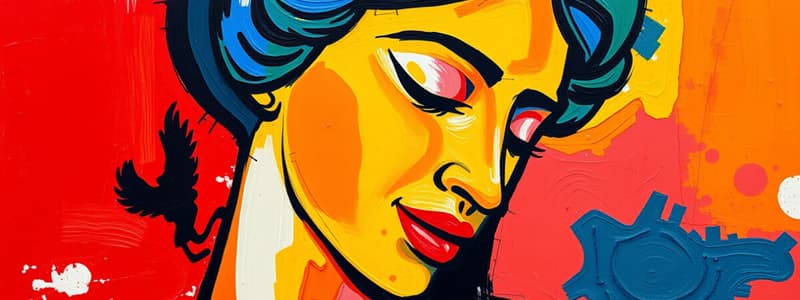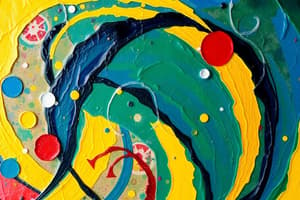Podcast
Questions and Answers
Which artistic discipline involves the use of pigments on surfaces?
Which artistic discipline involves the use of pigments on surfaces?
- Painting (correct)
- Photography
- Sculpture
- Printmaking
What type of art primarily involves the creation of three-dimensional works?
What type of art primarily involves the creation of three-dimensional works?
- Painting
- Drawing
- Sculpture (correct)
- Photography
Which of the following is NOT considered a medium in visual arts?
Which of the following is NOT considered a medium in visual arts?
- Ink
- Digital sensors
- Spoken word (correct)
- Charcoal
Which style of art is known for its use of drama, rich colors, and intense light and shadow?
Which style of art is known for its use of drama, rich colors, and intense light and shadow?
What element of visual art refers to the perceived surface quality of an artwork?
What element of visual art refers to the perceived surface quality of an artwork?
Which movement in visual arts is known for embracing abstraction and experimentation?
Which movement in visual arts is known for embracing abstraction and experimentation?
What does the term 'space' refer to in visual arts?
What does the term 'space' refer to in visual arts?
Which function of visual arts focuses on challenging norms and inspiring movements?
Which function of visual arts focuses on challenging norms and inspiring movements?
What defines color in the context of visual arts?
What defines color in the context of visual arts?
Which of the following is a technique associated with printmaking?
Which of the following is a technique associated with printmaking?
Flashcards are hidden until you start studying
Study Notes
Visual Arts
-
Definition: Visual arts encompass artistic disciplines that create works that are primarily visual in nature. This includes a wide range of mediums and practices.
-
Key Categories:
- Painting: Use of pigments on surfaces (canvas, paper, walls).
- Styles: Abstract, realism, impressionism, etc.
- Sculpture: Three-dimensional works formed from materials like stone, metal, clay.
- Techniques: Carving, modeling, casting.
- Drawing: Creation of images on a surface using tools like pencils, ink, and charcoal.
- Types: Sketching, technical drawing, illustration.
- Photography: Capturing images using light, often on film or digital sensors.
- Genres: Portrait, landscape, documentary.
- Printmaking: Techniques for creating artworks by printing, typically on paper.
- Methods: Etching, screen printing, lithography.
- Painting: Use of pigments on surfaces (canvas, paper, walls).
-
Styles and Movements:
- Renaissance: Emphasized realism, perspective, and human emotion.
- Baroque: Known for drama, rich colors, and intense light and shadow.
- Modernism: Broke away from tradition, embraced abstraction and experimentation.
- Contemporary Art: Reflects current issues and incorporates new mediums and technologies.
-
Elements of Visual Arts:
- Line: The path between two points; can be straight, curved, thick, thin.
- Color: Comprised of hue, value, and saturation; used to create mood and depth.
- Shape and Form: Two-dimensional shapes and three-dimensional forms that can be geometric or organic.
- Texture: The surface quality of an artwork, perceived through touch or visually implied.
- Space: The area around, between, and within objects; can create depth.
-
Functions of Visual Arts:
- Aesthetic: Provides beauty and pleasure to viewers.
- Expression: Communicates emotions, ideas, and social commentary.
- Cultural Significance: Reflects the values, beliefs, and history of societies.
- Social Change: Can challenge norms and inspire movements.
-
Art Criticism:
- Involves analysis, interpretation, and evaluation of visual artworks.
- Critiques can focus on technique, composition, content, and context.
-
Notable Artists:
- Leonardo da Vinci: Known for masterpieces like "Mona Lisa" and "The Last Supper."
- Pablo Picasso: Co-founder of Cubism, known for works like "Guernica."
- Frida Kahlo: Celebrated for her self-portraits and exploration of identity and pain.
- Yayoi Kusama: Known for immersive installations and polka dot motifs.
-
Influence of Technology:
- Digital art: Use of software and digital tools to create artworks.
- Virtual reality: New experiences in art consumption and creation.
- Social media: Platforms for artists to showcase and distribute their work.
Definition and Categories
- Visual arts create works primarily visual in nature across various mediums and practices.
- Major categories include painting, sculpture, drawing, photography, and printmaking.
Key Categories of Visual Arts
- Painting: Involves applying pigments on surfaces such as canvas or paper; includes styles like abstract and realism.
- Sculpture: Comprises three-dimensional works made from materials like stone or metal using techniques such as carving and casting.
- Drawing: The act of producing images on surfaces using tools like pencils or charcoal; includes types like sketching and illustration.
- Photography: Captures images through light on film or digital sensors, including genres like portraiture and landscapes.
- Printmaking: Involves creating artworks by printing, often using methods such as etching and screen printing.
Styles and Movements
- Renaissance: Focused on realism and perspective, highlighting human emotion.
- Baroque: Characterized by drama, rich colors, and contrasts of light and shadow.
- Modernism: Departed from traditional approaches, embracing abstraction and experimentation.
- Contemporary Art: Engages with current issues and integrates new mediums and technologies.
Elements of Visual Arts
- Line: The connection between two points; varieties include straight, curved, thick, and thin.
- Color: Composed of hue, value, and saturation, influencing mood and depth.
- Shape and Form: Two-dimensional shapes and three-dimensional structures can be geometric or organic.
- Texture: The perceived surface quality of an artwork, either through touch or visual implication.
- Space: Represents the area around and within objects, creating a sense of depth.
Functions of Visual Arts
- Aesthetic: Provides beauty and pleasure to viewers.
- Expression: Communicates emotions, ideas, and social commentary.
- Cultural Significance: Reflects societal values, beliefs, and history.
- Social Change: Helps challenge social norms and can inspire movements.
Art Criticism
- Involves analyzing, interpreting, and evaluating visual artworks, with critiques focusing on technique, composition, content, and context.
Notable Artists
- Leonardo da Vinci: Renowned for works like "Mona Lisa" and "The Last Supper."
- Pablo Picasso: Co-founder of Cubism, recognized for "Guernica."
- Frida Kahlo: Known for self-portraits exploring identity and pain.
- Yayoi Kusama: Famous for immersive installations featuring polka dot motifs.
Influence of Technology
- Digital Art: Leverages software and digital tools for creating artworks.
- Virtual Reality: Offers new dimensions for experiencing and interacting with art.
- Social Media: Serves as platforms for artists to display and disseminate their creations.
Studying That Suits You
Use AI to generate personalized quizzes and flashcards to suit your learning preferences.




